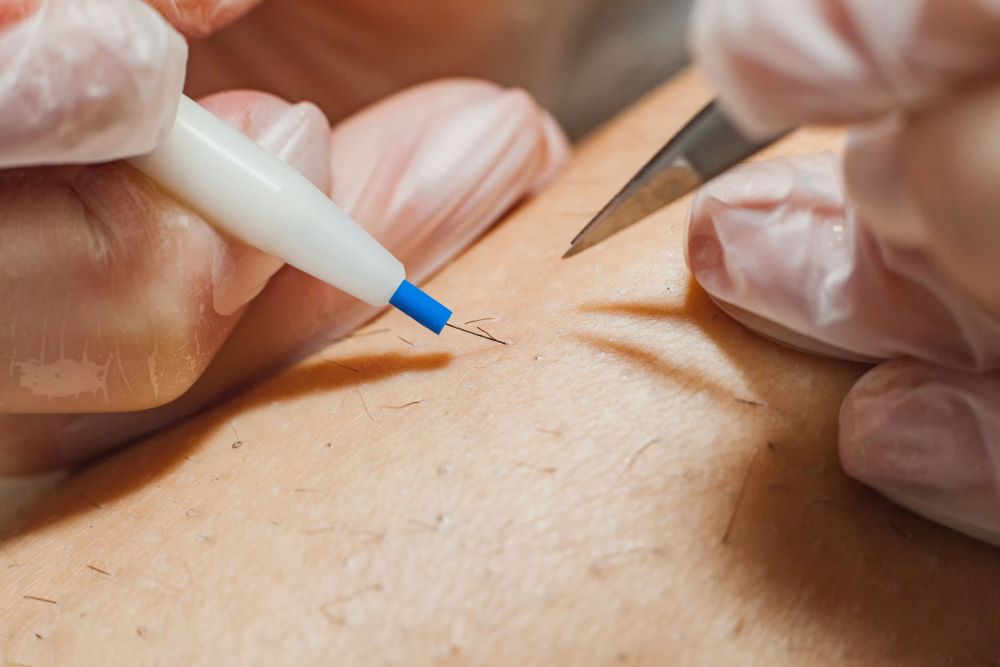Permanent hair removal – it’s the holy grail of cosmetics. Dozens of treatments, from hair removal creams to waxing, claim long-lasting results. However, only a few treatments can truly produce a permanent reduction in hair growth. Electrolysis is a popular method of hair removal. But, despite its success, many still ask: can hair grow back after electrolysis?
Electrolysis is a hair removal treatment involving the insertion of a needle into your skin. A current is passed through the needle, heating up the nearby follicle, causing it to become damaged. The goal is to prevent future regrowth by targeting the follicle itself permanently.
But does it work? Can hair grow back after electrolysis? That’s what we explain below.
Can hair grow back after electrolysis?
According to the Food and Drug Administration (FDA) and the American Medical Association (AMA), electrolysis is the only permanent form of hair removal. You’d be forgiven for thinking that means hair never grows back.
Unfortunately, that’s not always the case.
Some hairs will grow back after electrolysis. However, as you undergo more and more sessions, the number of hairs that grow back each time decreases. If the hair doesn’t regrow after more than three months, it will never come back again.
How does electrolysis kill the follicle?
Unlike other procedures, like laser therapy removal, electrolysis aims to kill off the hair follicle itself – not just reduce hair growth or appearance. It does this by cauterizing or burning the hair follicle using the probe. In so doing, it renders the follicle unable to produce hair going forwards.
But not all hair follicles will be affected during a single procedure. That’s why multiple procedures are standard. Typically, people can expect eight to twelve electrolysis sessions to achieve a significant and lasting result.
Why do some hairs grow back?
To understand why some hair grows back, we need to revisit a little biology.
There are two phases of hair growth: the growth phase and the resting (or dormant) phase. In scientific terms, the growth phase is known as anagen, and the resting phase is called telogen.
At any one time, around four out of ten hairs are in the resting phase. Suppose the follicle is in a dormant phase or even transitioning between phases. In that case, the electrical current will not prevent future growth. On the other hand, the hairs in the growth phase will be permanently affected.
The electrologist, therefore, can only treat the visible hairs. When these “invisible” hairs start growing, it is called false regrowth. If a growing hair, for whatever reason, wasn’t killed, it will continue to grow. This is called true regrowth.
That’s why you see some results after a single session – even if it’s not a complete fix. The total regrowth is all the hairs that appear after the first session.
Over multiple sessions, your electrologist will target the remaining hairs. Eventually, almost all hairs will have been treated, and the resulting lack of hair growth should be permanent.
What kind of hair regrowth can you expect?
Electrolysis can be expected to kill 50 to 60 percent of hair follicles during any one session. Therefore, you can reasonably expect a 40 to 50 percent regrowth of hair in the following weeks or months (assuming all growing hairs are successfully killed).
That’s true of every session.
Some regrowth will persist even after the second or third session because the resting hairs won’t all start growing ready for the next session. However, after the eighth to the twelfth session, results will become more permanent, as very few hair follicles remain alive.
After each session, you can expect the resting hairs to appear within the first week. The last untreated hair will become visible within six weeks – the maximum resting period.
How does hair regrowth compare to other treatments?
Commonplace hair removal treatments, like waxing or tweezers, do not produce permanent hair removal. Because these methods only remove the hair above the skin, the underlying follicle remains intact. Even chemical treatments aren’t as effective as many believe.
The most popular alternative to electrolysis is laser therapy. Here, a laser is targeted at the hair follicle, producing a similar burning that aims to cauterize the hair follicle. However, being more indirect, laser hair removal isn’t as likely to kill the hair follicle as electrolysis. Hair regrowth is more common, therefore. It is not considered a permanent form of hair removal, even if the effects are long-lasting.
Laser therapy does benefit from targeting melanin (color) in the hair. So, even though more hairs do grow back, they often do so lighter, finer, and scarcer than before.
Does electrolysis work on all hair follicles?
Yes. As electrolysis involves direct or nearby contact with the hair follicle, it can effectively be used on any hair. All hair follicles share similar biology. So, electrolysis works just the same regardless of whether the hair follicles are on your scalp, face, or body.
Electrolysis does carry some risks, however. Due to the electric current, electrolysis is not advised as a treatment for the insides of your ears or nose. These areas are rich in nerves and blood vessels. It is therefore potentially dangerous and damaging to introduce a current into the area.
Conclusion
After any one session, expect a 50 to 60 percent drop off in hair growth. During the initial few sessions, hairs will begin to regrow after one to six weeks – as these hairs were dormant at the time of the procedure. Over multiple sessions, previously dormant hairs will be targeted, eventually leading to complete and permanent hair removal. For more information on the laser hair removal process, contact Alite Laser today.


